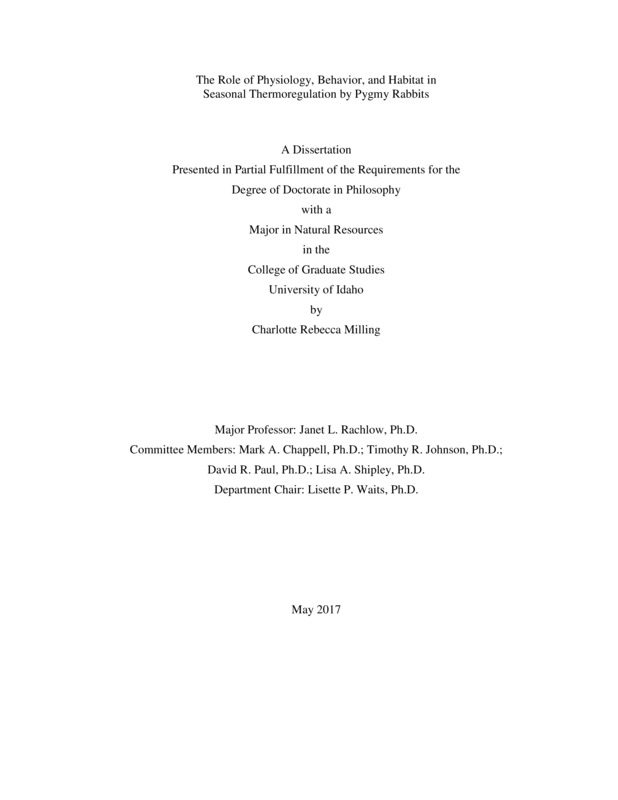The Role of Physiology, Behavior, and Habitat in Seasonal Thermoregulation by Pygmy Rabbits
Milling, Charlotte. (2017). The Role of Physiology, Behavior, and Habitat in Seasonal Thermoregulation by Pygmy Rabbits. Theses and Dissertations Collection, University of Idaho Library Digital Collections. https://www.lib.uidaho.edu/digital/etd/items/milling_idaho_0089e_11101.html
- Title:
- The Role of Physiology, Behavior, and Habitat in Seasonal Thermoregulation by Pygmy Rabbits
- Author:
- Milling, Charlotte
- Date:
- 2017
- Keywords:
- adaptive capacity antipredator behavior behavioral ecology resource selection security thermal resources
- Program:
- Natural Resources
- Subject Category:
- Wildlife conservation; Ecology; Climate change
- Abstract:
-
Understanding how organisms respond to the thermal environment is of increasing importance under global climate change. For species that are limited in their ability to disperse because of size, mobility, or habitat connectivity, coping in situ via behavioral plasticity or physiological acclimatization may reduce vulnerability. My objective was to evaluate factors contributing to thermoregulation strategies of a sagebrush-obligate, the pygmy rabbit (Brachylagus idahoensis), during summer and winter when regulatory costs imposed by the environment would be high. In both seasons, I 1) evaluated the thermal and security properties of rest-sites selected by pygmy rabbits; 2) explored the drivers underlying seasonal activity patterns to identify behavioral plasticity in response to the thermal environment; 3) used indirect-calorimetry to elucidate the relationship between energy expenditure and temperature; 4) evaluated the functional role of the burrow as a thermal refuge; and 5) used field-based measurements to relate habitat structure to the thermal environment, and used emerging unmanned aerial systems (UAS) technology to identify and map thermal microrefugia. Pygmy rabbits in eastern Idaho demonstrated a high capacity for behavioral thermoregulation by selecting shaded rest-sites during summer and reducing activity levels during periods of extreme cold during the winter. Although pygmy rabbits demonstrated seasonal physiological acclimatization, the burrow was an important thermal refuge, especially in winter when predicted thermoregulatory costs were often lower inside the burrow than in above-ground rest sites. Increasing habitat structure resulted in attenuated thermal environments across small spatial scales. Mapping efforts revealed considerable thermal heterogeneity and availability of thermal refugia across sagebrush-steppe habitat that is traditionally considered relatively homogeneous. This work contributes to understanding the capacity of pygmy rabbits to cope with thermal extremes in situ, which is associated with greater persistence under changing climates. Global climate change is expected to be the greatest conservation challenge that ecologists now face, and predictions of species responses can be improved by accounting for the processes that contribute to coping locally at spatial and temporal scales that are organism relevant.
- Description:
- doctoral, Ph.D., Natural Resources -- University of Idaho - College of Graduate Studies, 2017
- Major Professor:
- Rachlow, Janet L
- Committee:
- Chappell, Mark A; Johnson, Timothy R; Paul, David R; Shipley, Lisa A
- Defense Date:
- 2017
- Identifier:
- Milling_idaho_0089E_11101
- Type:
- Text
- Format Original:
- Format:
- application/pdf
- Rights:
- In Copyright - Educational Use Permitted. For more information, please contact University of Idaho Library Special Collections and Archives Department at libspec@uidaho.edu.
- Standardized Rights:
- http://rightsstatements.org/vocab/InC-EDU/1.0/

